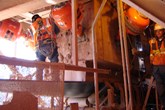The Mining Matrix: improving the image of mining
Published by Claire Cuddihy,
Assistant Editor
Global Mining Review,
According to a new paper published by multinational professional services company Deloitte, the mining community needs to educate, communicate and collaborate across the entire ecosystem of government, educators, the community, employees, customers, shareholders and other stakeholders in order to turn around the image of mining.
Yesterday, the Mining Matrix was launched at the 2018 Diggers & Dealers Mining Forum in Kalgoorlie (Western Australia). This platform explores how the interconnecting of four core industry trends: innovation, digital transformation, the Future of Work and the image of mining, can help to restore pride in the industry.
Deloitte’s Western Australia mining leader, Nicki Ivory, said: “Mining has long been the backbone of the Australian and West Australian economic and societal landscape, and yet for the past decade, its image has been in decline.”
“Stock price underperformance relative to other stocks, fractious community relations, legacies of weak environmental practices, and a historical lack of workforce diversity have all tarnished the reputation of the mining industry,” she explained.
Ivory added: “We need to communicate clearly the extent of innovation across the mining industry in Australia, the value digital disruption is already delivering in the sector, and the positive impact of the Future of Work on roles and jobs across the mining value chain.”
“We need to educate society of the value the industry delivers, and what more it can deliver in the future. We need to educate our potential employees of the future – the young students of today – in what the industry can offer; and we need to educate ourselves on their desires, needs and wants.”
“As a mining industry we need to collaborate more in areas of critical importance across the industry – areas such as skills and reskilling; the image of our sector; development of IP to bring about positive step change for the industry; and maintaining and enhancing our social licence to operate.”
The following describes key trends and how they interconnect in more detail:
Innovation: The mining sector is embracing technological innovation, but Deloitte research across Canada, Australia, Africa and Latin America shows the sector still lacks systemic consistency and strategic focus when it comes to innovation. Innovation includes the adoption of different approaches to engaging stakeholders, re-envisioning the Future of Work, and identifying the commodities that will be in greatest demand in the future, while continuing to push the boundaries harder from a digital perspective.
The need to demonstrate near-term returns combined with a traditionally risk-averse culture that does not foster collaboration can hinder efforts to innovate within the industry.
Digital transformation: While the majors have been investing in automation and technology innovation for several years, the industry is now seeing the digital agenda moving into the domain of the broader mining industry. Rapid advances in technology, along with decreasing costs overall, have meant that harnessing the power of digital has become more practical and achievable – to the extent it is now becoming an imperative for other industry players.
The Future of Work: The nature of work is poised to change dramatically, at both the mine site and in the back office, driven by technological and social trends affecting every industry across the globe. In mining, there have been significant strides over the past five years in areas such as automated equipment, remote operations centres, robotic process automation, and the creation of new organisational operating models that deliver greater agility and flexibility. Until the industry redefines the way work is done and delivered, many across the industry automating processes will not necessarily reap the rewards in a fundamentally different way to drive greater productivity, despite robotics in particular taking a significant foothold in the industry over the past 12 to 18 months.
New talent models are also following suit. As we move toward greater automation of roles across the mining sector, this has the potential to impact the social licence to operate for mining organisations and the reputation of the broader industry.
The image of mining: Negative perceptions can do more than damage reputations and affect stock prices. They can also spill over into the community and result in the loss of a social licence to operate. This mandates mining companies to take proactive steps to address, and change, their reputations.
The sector has the opportunity to reframe the conversation across society on the importance of mining. Not only the economic importance to Australia, but also the daily importance to a society which depends heavily on products that would not exist without mining, from smartphones to bridges, health technology and electric vehicles.
Read the article online at: https://www.globalminingreview.com/environment-sustainability/07082018/the-mining-matrix-improving-the-image-of-mining/
You might also like
Martin Engineering’s new Australian Managing Director shares industry insights
Martin Engineering has hired Darren Gilbert as Managing Director of its Australian Business unit and released a Q&A in which he shares some of his industry insights and experience.

